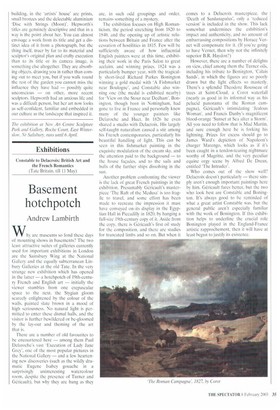Constable to Delacroix: British Art and the French Romantics (Tate Britain. till 11 May)
Basement hotchpotch
Andrew Lamb irth
Why are museums so fond these days of mounting shows in basements? The two least attractive suites of galleries currently used for important exhibitions in London are the Sainsbury Wing at the National Gallery and the equally subterranean Linbury Galleries at the old Tate. In the very strange new exhibition which has opened in the latter — a hotchpotch of 19th-century French and English art — initially the viewer stumbles from one crepuscular space to the next, the Stygian gloom scarcely enlightened by the colour of the walls, painted slate brown in a mood of high seriousness. No natural light is permitted to enter these dismal halls, and the visitor is further bewildered or be-gloomed by the lay-out and them ing of the art that is.
There are a number of old favourites to he encountered here — among them Paul Delaroche's vast 'Execution of Lady Jane Grey', one of the most popular pictures in the National Gallery — and a few heartening new discoveries (such as the wildly dramatic Eugene Isabey gouache in a surprisingly uninteresting watercolour room, despite the presence of Turner and Gericault), but why they are hung as they are, in such odd groupings and order, remains something of a mystery.
The exhibition focuses on High Romanticism, the period stretching from 1820 to 1840, and the opening up of artistic relations between Britain and France after the cessation of hostilities in 1815. Few will be sufficiently aware of how influential English painters were at this time, exhibiting their work in the Paris Salon to great acclaim, and winning prizes. 1824 was a particularly bumper year, with the tragically short-lived Richard Parkes Bonington winning a gold medal with 'A Fishmarket near Boulogne', and Constable also winning one (the medal is exhibited nearby) for 'View on the Stour near Dedham'. Bonington, though born in Nottingham, had gone to live in France and personally knew many of the younger painters like Delaroche and Huet. In 1826 he even shared a studio with Delacroix. His largely self-taught naturalism caused a stir among his French contemporaries, particularly his beautiful handling of light. This can be seen in this fishmarket painting in the exquisite modulation of the cream sky, and the attention paid to the background — to the house façades, and to the sails and hulls of the further ships dissolving in the sun.
Another problem confronting the viewer is the lack of great French paintings in the exhibition. Presumably Gericault's masterpiece 'The Raft of the Medusa' is too fragile to travel, and some effort has been made to recreate the impression it must have conveyed on its display in the Egyptian Hall in Piccadilly in 1820, by hanging a full-size 19th-century copy of it. Aside from the copy, there is Gericault's first oil study for the composition, and there are studies for truncated limbs and so on. But when it
comes to a Delacroix masterpiece, the 'Death of Sardanapalus', only a 'reduced version' is included in the show. This lack somewhat undermines the exhibition's impact and authenticity, and no amount of embarrassing compositions by Horace Vernet will compensate for it. (If you're going to have Vernet, then why not the infinitely superior B.R. Haydon?)
However, there are a number of delights on view, chief among them the Turner oils, including his tribute to Bonington, 'Calais Sands', in which the figures are so poorly drawn but the light effects so masterly. There's a splendid Theodore Rousseau of trees at Saint-Cloud, a Corot waterfall (nearly as good in its informal way as his pelucid panorama of the Roman campagna), Gericault's intimidating 'Jealous Woman', and Francis Danbv's magnificent blood-orange 'Sunset at Sea after a Storm'. All you need to follow that is Mad Martin, and sure enough here he is forking his lightning. Prizes for excess should go to James Ward's depiction of Napoleon's charger Marengo, which looks as if it's been caught in a tendon-tearing nightmare worthy of Magritte, and the very peculiar equine orgy scene by Alfred De Dreux, entitled 'The Intruder'.
Who comes out of the show well'? Delacroix doesn't particularly — there simply aren't enough important paintings here by him. Gericault fares better, but the two who look best are Constable and Bonington. It's always good to he reminded of what a great artist Constable was, but the general public aren't especially familiar with the work of Bonington. If this exhibition helps to underline the crucial role Bonington played in the England-France artistic rapprochement, then it will have at least begun to justify its existence.


























































 Previous page
Previous page